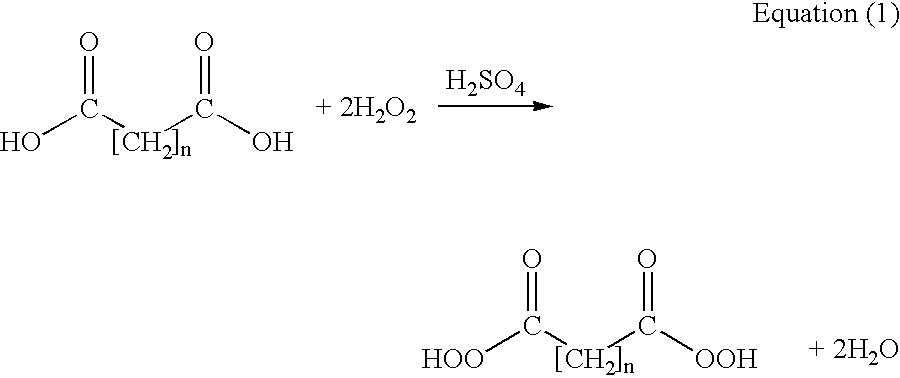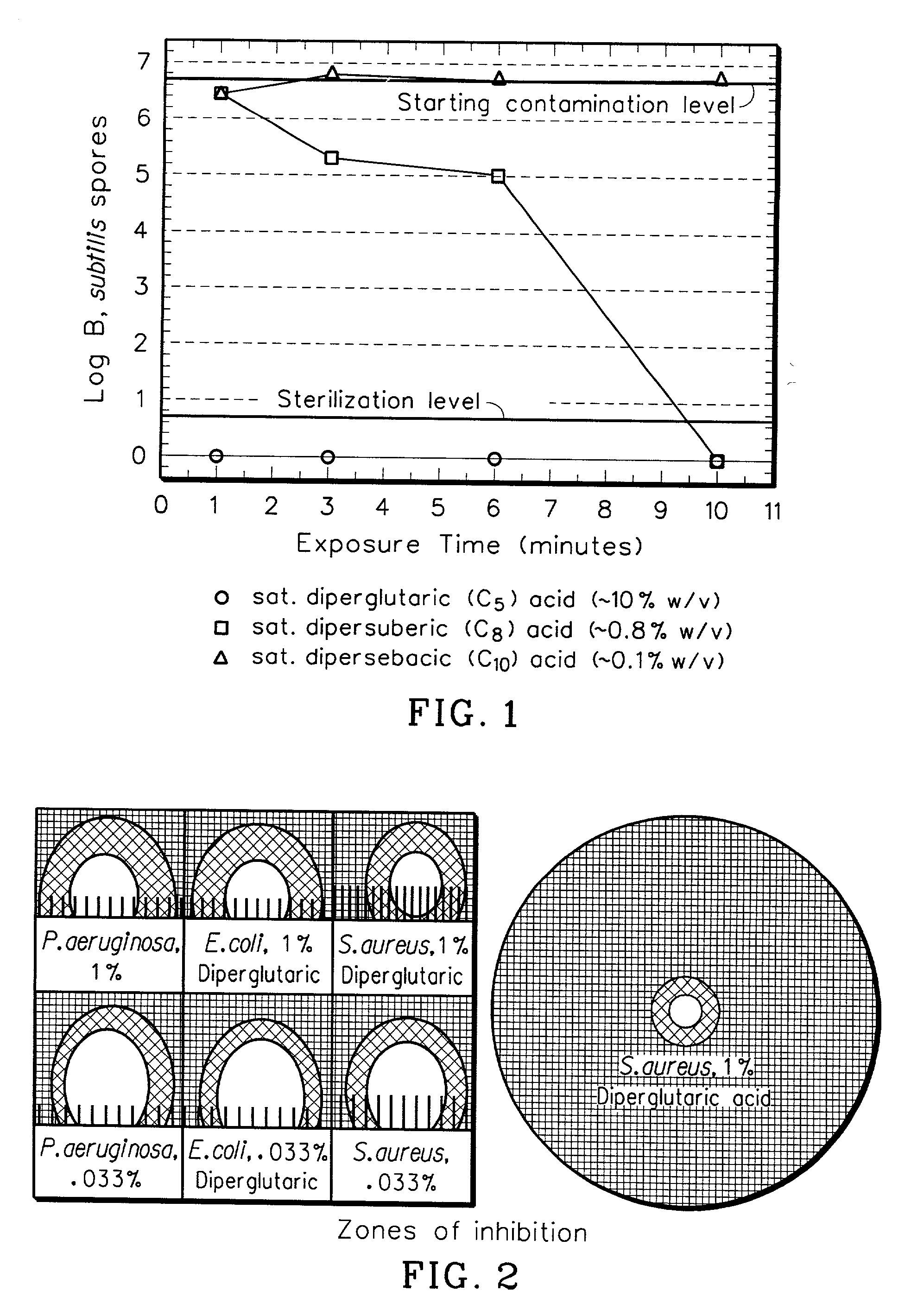Methods of sterilizing with dipercarboxylic acids
- Summary
- Abstract
- Description
- Claims
- Application Information
AI Technical Summary
Problems solved by technology
Method used
Image
Examples
example 2
Sterilization Rates of Dipercarboxylic Acids
[0028] A crude experiment was done to first estimate the solubility in water of diperglutaric acid (C5), dipersuberic acid (C8), and dipersebacic acid (C10) prepared in accordance with Example 1. It was estimated that the limit of solubility of these peracids in water was 10%, 0.8%, and 0.1% wt / v for diperglutaric, dipersuberic, and dipersebacic, respectively.
[0029] A saturated solution of each peracid was prepared in water. 1.2 mL of saturated peracid solution was placed in a 2 mL Eppendorf.RTM. tube. At t=0, 0.3 mL of a 2.5.times.10.sup.8 spores per mL solution was placed in the Eppendorf.RTM. tube and mixed. The final spore concentration was 1.7.times.10.sup.8 spores per mL. At various time points, a 0.2 mL aliquot (containing 3.3.times.10.sup.7 spores) was removed from the Eppendorf.RTM. and added to 0.4 mL of a 10% sodium thiosulfate, 10% bovine serum albumin solution. This solution quenches unreacted peracid. The final spore concentr...
example 3
Zones of Inhibition
[0030] Zone of inhibition tests are qualitative screens for the inhibitory effect of the compound being tested. Clear zones created by a compound on a bacterial lawn indicates bacteriostatic ability and possible bactericidal capability and the size of the zone of inhibition is a semi-qualitative measure of the strength of the compound. The procedure involved creating lawns of bacteria by spreading 100 .mu.L of broth culture evenly on nutrient agar plates. The bacteria were drawn from broth cultures that had recently reached maximum density. The organisms were Staphylococcus aureus, Psuedomonas aeruginosa, and Escherichia coli. Sterile, 6 mm, white paper discs were placed in the middle of each bacterial lawn. 20 .mu.L of treatment were dispensed onto the surface of each disc. The treatments were: 1.0% and 0.033% diperglutaric acid, 1.0% glutaric acid in water. Each treatment was performed in duplicate for each organism. The plates were incubated at 37.degree. C. fo...
example 4
Biopsy Punch
[0032] Biopsy punch enumeration is an extension of the zone of inhibition test, which involves enumerating organisms on the surface or within a removed core (punch). This test provides a quantitative analysis of the viable organisms remaining after treatment. This procedure was carried out exactly the same as the zone of inhibition testing. After incubation, however, the disc was removed from the plate and a 6-mm core was taken with a sterile, disposable biopsy punch precisely in the location where the disc had been removed. The same three organisms were used and the following treatments were sampled in duplicate: 1.0% diperglutaric acid and 1.0% glutaric acid in water. The core of each plate was aseptically placed in a microcentrifuge tube with 1 ml of sterile 0.85% saline solution and placed on a vortex for 5 minutes. These samples were diluted and plated in duplicate on nutrient agar and allowed to incubate at 37.degree. C. for 18-24 hours for enumeration.
[0033] Table...
PUM
| Property | Measurement | Unit |
|---|---|---|
| Percent by mass | aaaaa | aaaaa |
| Angle | aaaaa | aaaaa |
| Angle | aaaaa | aaaaa |
Abstract
Description
Claims
Application Information
 Login to View More
Login to View More - R&D
- Intellectual Property
- Life Sciences
- Materials
- Tech Scout
- Unparalleled Data Quality
- Higher Quality Content
- 60% Fewer Hallucinations
Browse by: Latest US Patents, China's latest patents, Technical Efficacy Thesaurus, Application Domain, Technology Topic, Popular Technical Reports.
© 2025 PatSnap. All rights reserved.Legal|Privacy policy|Modern Slavery Act Transparency Statement|Sitemap|About US| Contact US: help@patsnap.com



